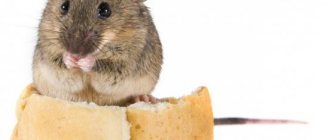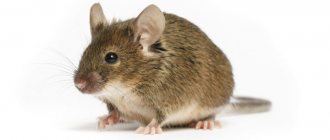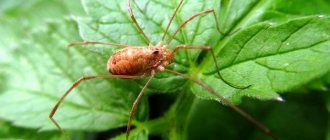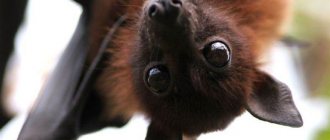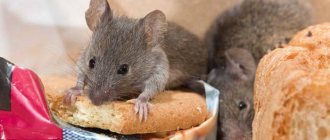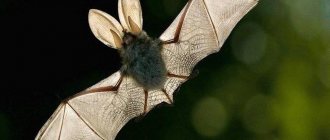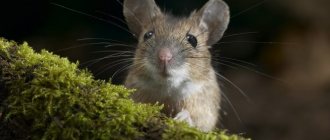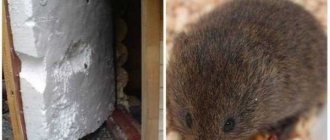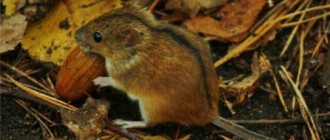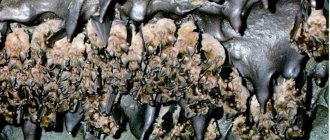Mice are animals that are quite rightly classified as one of the most widespread and numerous families. It includes many species found in all corners of the globe.
It is because of this diversity that confusion often arises, since not all creatures called mice belong to the mouse family. As an example, we can recall the sea mouse - a polychaete worm that lives on the seabed, or a bat belonging to the order Chiroptera.
Mouse - description, characteristics and photos. What does a mouse look like?
The length of the mouse’s body, covered with short fur, varies from 5 to 19 cm, depending on the species, and doubles with the tail. These rodents have a rather short neck. The pointed muzzle shows small black beady eyes and small semicircular ears, allowing the mice to hear well. Thin and sensitive whiskers growing around the nose give them the ability to perfectly navigate their surroundings. Mice, unlike hamsters, do not have cheek pouches.
The mouse's paws are short with five prehensile toes. The surface of the tail is covered with keratinized scales with sparse hairs. The color of the mouse is usually characterized by gray, brown or red tones, but there are variegated and striped individuals, as well as white mice. Animals lead an active lifestyle in the evening or at night. They communicate with each other using a thin squeak.
General characteristics of the mouse family
Despite the diversity of species, all mice have common features in appearance, structure, and habits:
- small sizes - for most types from 6 to 12 cm;
- body covered with hair;
- triangular, elongated muzzle;
- protruding round ears;
- short paws with tenacious clawed toes;
- the presence of four front incisors (2 above and 2 below), which grow throughout the animal’s life.
Mice
Speaking about external differences, one cannot fail to mention that a mouse is a rodent with a long tail (its length can be from 60% of the body length, or may exceed it).
As for habits, mice have a lot in common here too. Most of them lead a secretive lifestyle, being active at night. But it also happens that rodents change their daily routine, depending on the conditions in which they live. Typically, animals dig holes or settle in natural shelters, for example, under fallen trees, between stones, in a pile of dead wood or construction debris.
Mice are very fertile and can reproduce year-round. During the year, a female can bring offspring up to 8–10 times, but more often this happens 4–5 times, mainly in the warm season. One litter contains from 2 to 12 mice (average 5–8). The cubs are born without hair, blind and deaf, but after 3-4 weeks they become completely independent, and at the age of 2.5-3 months they are able to reproduce.
The average lifespan of wild mice is 1–2 years, while decorative mice live 3–5 years.
Types of mice, names and photos
The mouse family includes 4 subfamilies, 147 genera and 701 species, the most common of which are:
- Field mouse (Apodemus agrarius)
reaches 12.5 cm in size, not counting the tail, which can be up to 9 cm long. The color of the back of the mouse is gray, with a slight yellowish-brown tint and a dark stripe running along the ridge, and the belly is light gray. The habitat of the field mouse includes Germany, Hungary, Switzerland, Poland, Bulgaria, the southern part of Western Siberia and Primorye, Mongolia, Taiwan, the Korean Peninsula and certain territories of China. This species of mice lives in wide meadows, in dense thickets of bushes, city gardens and parks, and makes a refuge both in burrows and in any natural shelters. In flooded areas it builds nests on bushes. Depending on the season, the diet may consist of seeds, berries, green parts of plants and various insects. The field mouse is the main pest of grain crops.
Harvest mouse
- Yellow-necked mouse (Apodemus flavicollis)
has a reddish-gray color and a light belly (sometimes with a small yellow spot). The body size of adult individuals reaches 10-13 cm, the tail has approximately the same length. The mouse weighs about 50 grams. This type of mouse is widespread in the forests of Russia, Belarus, Moldova, Bulgaria, Ukraine, the Caucasus, the northern provinces of China and Altai. Yellow-throated mice live on open edges in hollow trees or dug holes, but they can also live in rocky areas. Their diet includes both plant and animal foods. By eating young shoots of fruit trees, they cause significant harm to nurseries.
Yellow-necked mouse
- Grass mouse (Nilotic grass mouse) (Arvicanthis niloticus)
is one of the largest representatives of the mouse family and can reach 19 cm in length, and with the tail - 35 cm. The weight of individual large individuals exceeds 100 g. The fur of the back and sides is dark gray or grayish-brown in color with some hard and prickly bristles of a darker shade. The belly color is light gray. This type of mouse is most common in African countries, where they live in bushes, forests and savannas. As a refuge, grass mice choose abandoned termite mounds or dig holes on their own, but on occasion they can enter human habitation. The basis of the diet of mice is plant food.
grass mouse
- Little mouse (Micromys minutus)
is one of the smallest rodents in the world. The body length of an adult animal does not exceed 7 cm, the tail - 6.5 cm, and the weight of the baby does not exceed 10 g. The back and sides are plain and have a reddish-brown or brown color, in contrast to the light gray, almost white belly. The muzzle of baby mice is short and blunt, with small ears. The distribution area of this species of mice stretches from west to east from the northwestern provinces of Spain to Korea and Japan, in the south to Kazakhstan, China and the northern regions of Mongolia. The mouse lives in forest and forest-steppe zones, in meadows with tall grass. In the summer, mice use nests made in the grass as shelter, and overwinter in burrows, haystacks, and human residential or outbuildings. The basis of the diet of baby mice is the seeds of cereals and legumes, as well as small insects. They often settle near granaries, causing enormous damage to agriculture.
Little mouse
- House mouse (Mus musculus)
the most widespread species of the rodent family on the planet. The body length of an adult mouse does not exceed 9.5 cm, and together with the tail - 15 cm. The weight of the mouse is 12-30 g. The color of the fur on the sides and back is gray with a brown tint, and on the abdomen from light gray to white. Individuals living in desert areas are sandy in color. The mouse's muzzle is sharp with small rounded ears. The distribution range of this species of mice does not include only the territory of the Far North, Antarctica and high mountain regions. House mice live in all types of landscapes and natural areas, and very often penetrate into human outbuildings and residential buildings. In natural conditions, they dig minks on their own, although they can also occupy homes abandoned by other rodents. They feed on seeds and juicy green parts of plants, and once they enter a person’s home, they eat everything they can get their teeth into – from bread and sausages to paraffin candles.
House mouse
- Striped mouse (Lemniscomys striatus)
small rodent: body length 10-15 cm, intermittent stripes of light colors are visible along the back and along the sides. Under natural conditions, striped mice rarely live more than 6-7 months; in captivity they live two to three times longer. The menu of these individuals includes mainly plant “dishes”: root vegetables, soft seeds, juicy fruits, and occasionally small insects.
Striped mouse
- Spiny mouse ( Acomys)
a rather handsome representative of the mouse family, the owner of huge eyes and equally large ears. The size of the spiny mouse, including its tail, is 13-26 cm; the back of the animal is covered with thin spines, like a regular hedgehog. An amazing feature of these animals is regeneration: when in danger, the mouse is able to shed a piece of skin, leaving the attacker bewildered. The skin is quickly restored without damage to the individual. The spiny mouse lives in Asian countries and is found in Cyprus and Africa. Its diet relies on plant foods; this animal is often kept as a pet.
Spiny mouse
What types are most common?
approximately 300 species of wood and field mice worldwide . Most of them are found in warm countries (Africa and Asia); fewer species live in Australia and Eurasia. Here are the births that occur in a person’s life:
- wood mouse;
- harvest mouse;
- house mouse;
- mole vole;
- yellow variegation;
- steppe moth;
- voles: underground, dark, flat-skulled, narrow-skulled, Brazilian;
- red and bank voles;
- housekeeper voles;
- gray vole;
- earth rat.
Where does the mouse live?
The distribution range of mice covers almost all climatic zones, zones and continents of the globe. Mouse representatives can be found in tropical thickets, coniferous or deciduous forests, steppes and deserts, on mountain slopes or in swampy areas. Mice also live in people's homes.
Mice can build nests from grass stems, occupy abandoned burrows, or dig complex systems of underground passages. Unlike species that live in swamps, mountain, steppe and forest mice swim poorly.
Sense organs (eyes, ears and teeth)
The bat's eyesight is poor, but its ears can detect the slightest rustle several meters away. The auricle is huge.
Before flying, pushing off from the surface, the animal emits a piercing squeak, which, when it encounters an obstacle, returns. This echolocation allows one to navigate at night and serves as a technique for catching prey.
Eyes of medium size. Set on the front of the muzzle. Vision is black and white. When sunlight appears or imitates it, the bird experiences pain.
The jaw consists of incisors, molars, premolars, and canines. The pungency, shape and quantity depend on the nutrition of the chiropteran creature:
- In insectivores - 38, long, shaped like a mortar; in bloodsucking - 20-26 teeth, sharp, large on a well-developed jaw.
What does a mouse eat?
The basis of the diet of mice is plant food: grass seeds, fruits of trees or shrubs and cereals (wheat, oats, barley, millet, buckwheat). Mice that live in swampy areas, wet and flooded meadows, feed on leaves, buds or flowers of plants and shrubs. Some types of mice prefer protein supplements such as insects, worms, beetles, and spiders. Once in homes, these animals happily gnaw on potatoes, sausage, baked goods, eggs or cheese.
The mouse does not hibernate in winter and can move under the snow crust without appearing on the surface.
To survive the cold, she has to create substantial food reserves in pantries located near the entrance to the burrow.
How to deal with house mice
Mice in a person's home are a source of unpleasant odors, noise and debris. They leave behind chewed parts and remains of vital activity. In addition, these pests carry various diseases and spoil food.
To protect your home, you need to keep your house and grounds clean. It is believed that the smell of a dog or cat living on the property repels rodents. But as practice shows, this does not always work; mice easily adapt.
But there are animals that enjoy eating mice.
The fight against harmful rodents begins with cleaning the premises. It is necessary to understand where the animals found a secluded place. This will make it clearer how many animals have settled. After this, the method of fight is already determined - sometimes it is enough to set a mousetrap, but in advanced cases more aggressive methods will be required.
Of the 50 ways to combat rodents, everyone will find one that suits them.
What to feed mice at home?
Although pet mice eat many foods, not all of them are recommended for your pets, because there are foods that are not only harmful, but also dangerous for rodents. This is why it is important to properly feed mice at home to keep them healthy, active and energetic.
The best option for feeding domestic rodents is ready-made balanced food, which can be purchased at any pet store. It is important to note that it is worth choosing “Mouse Food”, since it does not contain components harmful to pets. Experts recommend giving preference to imported feed, as they:
- do not contain dyes;
- consist of natural and healthy ingredients, not husks and coarse herbs;
- contain a small percentage of nuts and seeds, overeating of which threatens the animal with obesity.
Such nutrition will allow the house mouse to feel good, while receiving a full range of vitamins and nutrients.
In nature, mice feed on seeds and some types of animal food, so you need to provide your pets with a natural diet. Pet mice are given:
- seeds;
- cereals (barley, oats, wheat);
- protein products (quail eggs, boiled shrimp or meat);
- fresh vegetables (beets, carrots, pumpkin);
- fruits (apples, grapes, melon)
- greens (lettuce leaves, young shoots of nettle, twigs of apple or raspberry);
- bread;
- cheese (occasionally, as a treat).
Also, do not forget about water, which should always be in your pet’s cage.
What class of animals does a bat belong to?
A unique and at the same time terrifying creation of nature is the bat. The animal belongs to the class of chiropteran mammals. The exemplary behavior of parents will make anyone who sees the mother’s care touch. The female is capable of raising someone else's child if necessary. Zoologists call flyers altruists.
Microchiroptera became special for many reasons:
- high sensitivity to light and ultrasound; the only animals of the mammalian class that are able to fly; in the dark they develop speeds of more than 45 km/h; they have a special way of orientation at night.
Scientists have been arguing for a long time about the identity of the bat. The creature has characteristics of both animals and birds.
Mice breeding
Species of mice living in natural conditions reproduce with the onset of the warm season, and those living in houses or apartments reproduce all year round. There are no mating rituals among rodents, but if two male mice claim one female, a fight often occurs between them. The female's pregnancy lasts about 24 days, and up to 10 pups can appear in one litter. One female mouse produces up to 4 litters per year. Sexual maturity of individuals occurs after 2-3 months. The lifespan of mice in natural conditions does not exceed 9 months, and in captivity this figure can reach 8 years.
House mice are used as test animals for testing new drugs, cosmetics, and genetic experiments.
Unfortunately, these rodents are not only a great threat to crops and tree seedlings, but also carriers of dangerous infectious diseases.
How long do tailed tenants live?
Very often no more than a year. Only in human housing, under the most favorable conditions, can they live up to two years. In a human home, mice are more protected from unfavorable conditions. That's why they live longer. On the contrary, in the wild, where there are many more dangers and food is inconsistent, mouse mortality is higher and life expectancy is noticeably lower.
Moreover, females often “outlive” males. There are few long-livers among the latter. Many die before reaching the age of one year. In other words, females are more hardy and resilient in this regard.
Breeding mice at home
Decorative species of mice often become pets. They quickly get used to their owner and easily find him by smell. To keep them, you need a spacious glass terrarium, equipped with a drinker, feeder and house. Caring for mice is not difficult; you just need to change the bedding in a timely manner, give food and not touch newborn mice with your hands.
The role of smell in the life of small rodents
Orientation by smell is the most important for these animals. Since they lead a twilight and nocturnal lifestyle, their eyesight is weakest. The animals rely on it to the least extent. Things are a little better with the sense of touch and hearing. However, it is the olfactory organs that are decisive in their life activity, orientation in space and interaction with each other.
Based on odors, mice in the house divide the territory, marking it with their pheromones. The sense of smell helps them identify strangers and find “their own”. Little mice find their mother by smell. Males identify females, and females become ready for mating by sensing adult males. When two males meet, they begin to secrete a pheromone, which causes aggression in the opponent. This encourages them to fight each other and find out who is stronger and more important.
In other words, it is difficult to overestimate the role of olfactory receptors in the life of mice. If animals are somehow deprived of their olfactory abilities, then they will actually be doomed to death. Not only will they not be able to find food for themselves. The critters will not even understand where their territory is, where they are and where they are, who is dominant in their family, etc. Such mice will become completely defenseless and will soon simply die.
What else to read about rodents:
– Features of the life activity of the gray rat. Part 1.
– Black rat – photo, description, danger
– Deratization – what is it?
– Dangerous diseases caused by rodents
– Professional methods of rodent control
– Which rodent repeller should I choose?
Wool
The creature, based on the descriptions of different species, also differs in color. In 75% of cases, the mammal is gray, dark gray, or brown. This coloring helps to hide from predators and makes them invisible at night.
Mexican piscivorous species have yellow or orange fur. Some species are light yellow in color. Representatives of Honduras are albinos with yellow ears and nose.
The body and head are covered with fur. The wings are bare, with soft skin. This feature also applies to young nocturnal animals. The fur can be thick or sparse, with long or short pile. The habitat of the species plays a role here.
Interesting fact! There really is a vampire bat. But it feeds exclusively on the blood of small animals. It poses no danger to humans, even if she is very hungry. Maximum harm from flyers: babies fly poorly, so a collision may occur. Only the cub suffers from such blows.
